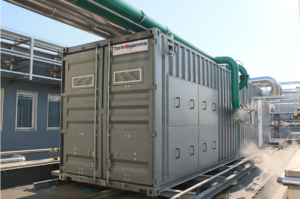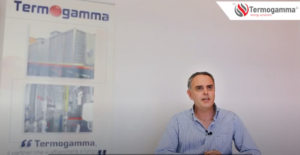What type of cogeneration plant is best suited for an industry?
Cogeneration technology is dotted with different types of plants that have established themselves in some contexts depending on their purposes and methods of operation.
We can divide these categories into macro-areas that differ fundamentally by the “prime engine” used.
Therefore, you can find: cogeneration plants with Otto or Diesel cycle alternative engines, with steam turbines, with gas turbines or combined cycle (gas turbines and steam turbines).
Let’s briefly analyze the main characteristics of the different configurations.
Cogeneration with steam turbines
Cogeneration plants with steam turbines were the most used during the 20th century.
The heart of the plant is represented by a turbine, but to pruduce steam and the condensation of steam once out of the turbine are necessary a boiler and a condenser.
Although they have a long operating life, they have several disadvantages, such as poor electrical efficiency for small sizes ( < 5 MW ) and high costs of auxiliary systems (boiler and condenser).
The overall efficiency is around 80% but consists mostly of the thermal part that is recovered from the steam output from the turbine, in fact the maximum electrical efficiency obtainable with these cogeneration plants is 20%.
Starting sizes: 1 MW – 300 MW
Average life: > 25 years
Cogeneration with Otto cycle engines
These machines generate mechanical energy through the combustion of the air-fuel mixture in a cylinder. Also in this case an electric generator converts mechanical energy into electricity.
There are two sources of thermal energy: exhaust fumes and the engine jacket.
The first source provides hot water up to 90 ºC or steam, while the second provides low temperature thermal energy.
The electrical efficiency of these cogenerators is between 30 and 40% with an overall efficiency of about 85/90%.
Starting sizes: 50 kW – 5 MW
Average life: 15 years
Cogeneration with a combined cycle
Cogeneration with a combined cycle In this configuration, the steam turbines are coupled with the gas turbines in a single plant, for this reason, they are called combined cycle or turbogas.
Their peculiarity lies in exploiting all the heat recovered from the first gas turbine to power the second steam turbine.
This phase, made possible by the transition from a recovery boiler, that allows the concentration of the primary energy input in the production of electricity only.
To ensure that the combined cycle is advantageous, the size of these plants starts from 5 MW and they are usually used directly in large power plants.
Starting sizes: 5 MW – 350MW
So, what kind of solution is best for my company?
It varies, but considering the sizes and dimensions of the plant at stake for the industrial sector, usually the most appropriate choice is that of a cogeneration plant with Otto cycle engines.
These are considered the most flexible and reliable and above all do not require connection with high-pressure gas, a necessary requirement for turbine cogeneration. “
Why then Termogamma?
Because Termogamma is a true tailor of cogenerative solutions with eight-cycle engines, a company that puts forward people and the care of the empathic aspect of every relationship to the mere sale.
For this reason, in 35 years of development has always highlighted and tried to develop to a greater extent the phases that distinguish it from other players in the industry, such as listening to the real needs of the customer, total flexibility on the solutions offered and maintenance service designed to generate long-lasting relationships based on trust.
Due to the company’s size Termogamma can truly follow the customer through his doubts, offering in conclusion a unique solution and designed specifically for his company.
Termogamma takes care of every aspect and stage of the journey that a customer takes after the desire to embrace a green policy.
The services offered to accompany the customer from the genesis of the idea of installing a cogeneration plant to the death of the cogeneration solution.


